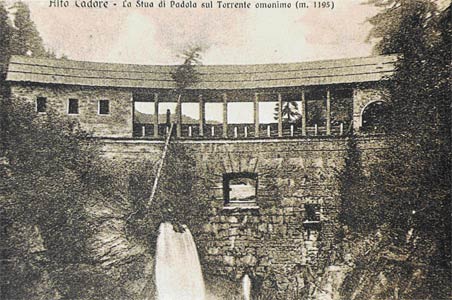| Card n. | Description | Locality | Linked sites |
| 6 | "Stua" on the Padola torrent | Comelico Superiore, Padola | 63 |
| file .pdf | Ethnographical Sites (SE) | Google maps |
 |
- Description
- How to get there
- Interesting facts
- Bibliography
This is a semi-elliptical masonry dam topped with a more recent wooden cover, which was used to block or to regulate the flow of water off the Padola torrent and to manage the transport of selected, counted trunks of timber down towards the Piave. Documents mention the presence of such a stua or stuffa as far back as the 14th century; originally built in wood, it was reconstructed in stone, after changing hands several times, by the Gera family of Candide, who had owned it since 1635. It was used up until after WWI, and considered by Albert di Berenger in the mid-19th century as one of the most advanced works of its kind to regulate waters, since “it bars the Pàdola torrent downriver, and has four outlets: two drainage outlets, which are opened when the trunks are not to be floated through, plus the gate and the overflow vent. The gate serves two purposes: it lets the timber trunks pass through one at a time, first closing the two drainage outlets so that the water rises to the threshold level, and it is also used to load and unload the stuffa, which takes place as follows. After allowing through the gate the number of pieces of timber the water blocked in front of the dam is able to shift, and having collected them in the basin below, the gate is then closed, and piles of them are left at the height of the outflow vent. At this point, the gate of the stuffa is opened, and the water thus rushes in, filling up the basin in a matter of seconds, and a vortex is created that lifts up the timber collected there and transports it swiftly down for two or three miles”. The construction is 16 metres above the current level of the watercourse, is 6 metres thick and about 30 metres long right to the crown. In the central part there are four openings – two drainage outlets, the gate and the overflow vent –, while above the dam is a reconstruction of the areas that once provided accommodation for the workers in charge of sorting the timber, now equipped with explanatory photographic panels.
From the village of Padola, take Via Stua and go along the path that starts out at the end of the road and runs through the fields alongside the Padola. From the main path, indicated by a wooden noticeboard, a route heads down to the tip of the dam over the Padola torrent.
ACCESSIBLE: may be visited
MUNICIPALITY: Comelico Superiore
PLACE: Padola
GEOGRAPHICAL COORDINATES: X 1767040 – Y 5166742
PROVINCE: Belluno
FILE COMPILED BY: Antoniol
The one in Padola is the only surviving example of the numerous stue that were once used in the timber industry for transporting trunks from the woods to half-way down the Piave. The other stue there are documentary references to were to be found on the Visdende canal, as early as 1580, in Longiarù di Lozzo in 1589, in Val Vedessana at Calalzo, on the Cridola torrent in Lorenzago, on the Boite from 1688 and in 1434 on the Rin brook in Auronzo.
A. Bondesan, G. Caniato, F. Vallerani, M. Zanetti, The Piave, Sommacampagna,2000
S. De Vecchi, La Stua del Pàdola in Archeologia industriale nel Veneto, Venice, 1990
I. Alfarè Lovo, Le vie del legno. Itinerari fra boschi, acque e residenze di commercianti di legnami in Comelico e Sappada, no editor, no date (2000)
G. Caniato, M. Dal Borgo, Dai monti alla laguna: produzione artigianale e artistica del Bellunese per la cantieristica Veneziana, Venice, 1988
G. Fabbiani, Appunti per una storia del commercio del legname in Cadore, by CCIA BL, 1959

